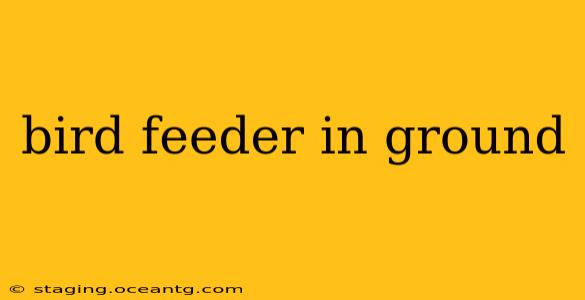Ground bird feeders offer a unique way to attract a diverse range of avian visitors to your backyard. Unlike hanging feeders, which primarily cater to acrobatic species, ground feeders provide easy access for birds that prefer foraging on the ground, such as sparrows, juncos, towhees, and doves. This comprehensive guide will delve into the benefits, types, placement, and maintenance of ground bird feeders, ensuring you create a thriving haven for your feathered friends.
What are the benefits of using a ground bird feeder?
Ground feeders provide several advantages. They attract a wider variety of bird species compared to hanging feeders, as many birds are more comfortable feeding on the ground. This allows you to observe different feeding behaviors and enjoy a greater diversity of birdlife in your garden. Furthermore, ground feeders are often easier to fill and clean, making them a convenient option for bird enthusiasts of all experience levels. They are also generally more accessible for people with mobility issues.
What types of ground bird feeders are available?
The market offers various ground feeders, each designed to cater to specific needs and preferences:
- Platform Feeders: These are simple, flat surfaces that provide ample space for birds to feed simultaneously. They're ideal for larger groups of birds but can be prone to spillage and attract unwanted critters like squirrels.
- Suet Feeders on the Ground: While suet feeders are typically hanging, some are designed for ground placement, providing a high-energy food source for birds during colder months. Ensure the feeder is weighted to prevent tipping.
- Dish Feeders: These resemble shallow dishes or bowls and are easy to clean and fill. They're a good middle ground between platform feeders and more contained options, offering space without excessive spillage.
- Tube Feeders with Ground Base: Some tube feeders have a base designed for ground placement, combining the benefits of protected seed dispensing with ground-feeding access.
What kind of birdseed is best for a ground feeder?
The best birdseed for a ground feeder depends on the birds you wish to attract. However, a good general mix usually includes:
- Black oil sunflower seeds: A favorite of many ground-feeding birds, these seeds are high in fat and energy.
- White proso millet: A less expensive option that attracts sparrows and other ground feeders.
- Cracked corn: Attracts doves and other larger ground birds.
Avoid using seeds with added fillers, as these are often less nutritious and less appealing to birds.
How do I keep squirrels away from my ground bird feeder?
Squirrels are notorious for raiding bird feeders. To deter them from your ground feeder:
- Choose a squirrel-resistant feeder: Some feeders have features like baffles or cages that prevent squirrels from accessing the seed.
- Elevate the feeder slightly: Raising the feeder a few inches off the ground can make it more difficult for squirrels to reach.
- Use a feeder with a weight-activated mechanism: These feeders close when a heavy animal like a squirrel attempts to feed.
- Provide alternative food sources: Scatter some seed or nuts away from the feeder to distract squirrels.
How often should I clean my ground bird feeder?
Regular cleaning is crucial to prevent the spread of disease among birds. Aim to clean your ground feeder at least once a week, or more often during hot and humid weather. Use warm, soapy water and thoroughly rinse before refilling with seed.
What is the best location for a ground bird feeder?
The best location for a ground feeder offers:
- Protection from the elements: Ideally, place the feeder in a sheltered spot, away from direct wind and rain.
- Easy access for birds: Position it near shrubs or other cover where birds can feel safe.
- Clear visibility for observation: Choose a location where you can easily observe the birds feeding.
- Away from predators: Keep the feeder away from areas where cats or other predators may lurk.
By following these guidelines and selecting the right type of ground feeder, you can create a welcoming and thriving environment for a diverse range of beautiful birds, enhancing your backyard's natural appeal and offering hours of enjoyable birdwatching. Remember, providing a clean, well-stocked, and strategically placed ground bird feeder is key to attracting and supporting your local avian community.
